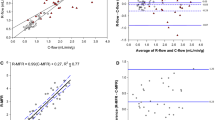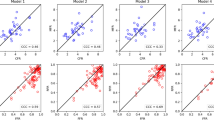Abstract
Background
Estimation of myocardial blood flow (MBF) with cardiac PET is often performed with conventional compartmental models. In this study, we developed and evaluated a physiologically and anatomically realistic axially distributed model. Unlike compartmental models, this axially distributed approach models both the temporal and the spatial gradients in uptake and retention along the capillary.
Methods
We validated PET-derived flow estimates with microsphere studies in 19 (9 rest, 10 stress) studies in five dogs. The radiotracer, 13N-ammonia, was injected intravenously while microspheres were administered into the left atrium. A regional reduction in hyperemic flow was forced by an external occluder in five of the stress studies. The flow estimates from the axially distributed model were compared with estimates from conventional compartmental models.
Results
The mean difference between microspheres and the axially distributed blood flow estimates in each of the 17 segments was 0.03 mL/g/minute (95% CI [−0.05, 0.11]). The blood flow estimates were highly correlated with each regional microsphere value for the axially distributed model (y = 0.98x + 0.06 mL/g/minute; r = 0.74; P < .001), for the two-compartment (y = 0.64x + 0.34; r = 0.74; P < .001), and for three-compartment model (y = 0.69x + 0.54; r = 0.74; P < .001). The variance of the error of the estimates is higher with the axially distributed model than the compartmental models (1.7 [1.3, 2.1] times higher).
Conclusion
The proposed axially distributed model provided accurate regional estimates of MBF. The axially distributed model estimated blood flow with more accuracy, but less precision, than the evaluated compartmental models.









Similar content being viewed by others
References
Bellina CR, Parodi O, Camici P, et al. Simultaneous in vitro and in vivo validation of nitrogen-13-ammonia for the assessment of regional myocardial blood flow. J Nucl Med 1990;31:1335-43.
Schelbert HR, Phelps ME, Huang SC, et al. N-13 ammonia as an indicator of myocardial blood flow. Circulation 1981;63:1259-72.
Krivokapich J, Smith G, Huang S, et al. 13N ammonia myocardial imaging at rest and with exercise in normal volunteers. Quantification of absolute myocardial perfusion with dynamic positron emission tomography. Circulation 1989;80:1328-37.
Hutchins G, Schwaiger M, Rosenspire K, Krivokapich J, Schelbert H, Kuhl D. Noninvasive quantification of regional blood flow in the human heart using N-13 ammonia and dynamic positron emission tomographic imaging. J Am Coll Cardiol 1990;15:1032-42.
Zierler K. A critique of compartmental analysis. Annu Rev Biophys Bioeng 1981;10:531-62.
Bassingthwaighte JB, Wang CY, Chan IS. Blood-tissue exchange via transport and transformation by capillary endothelial cells. Circ Res 1989;65:997-1020.
Larson KB, Markham J, Raichle ME. Tracer-kinetic models for measuring cerebral blood flow using externally detected radiotracers. J Cereb Blood Flow Metab 1987;7:443-63.
Muzic RFJ, Saidel GM. Distributed versus compartment models for PET receptor studies. IEEE Trans Med Imaging 2003;22:11-21.
Kuhle WG, Porenta G, Huang SC, et al. Quantification of regional myocardial blood flow using 13N-ammonia and reoriented dynamic positron emission tomographic imaging. Circulation 1992;86:1004-17.
Hutchins GD, Caraher JM, Raylman RR. A region of interest strategy for minimizing resolution distortions in quantitative myocardial PET studies. J Nucl Med 1992;33:1243-50.
Muzik O, Beanlands R, Hutchins G, Mangner T, Nguyen N, Schwaiger M. Validation of nitrogen-13-ammonia tracer kinetic model for quantification of myocardial blood flow using PET. J Nucl Med 1993;34:83-91.
Raymond GM, Butterworth EA, Bassingthwaighte JB. JSim: mathematical modeling for organ systems, tissues, and cells. FASEB J 2007;21:A827-c.
Chan IS, Goldstein AA, Bassingthwaighte JB. SENSOP: a derivative-free solver for nonlinear least squares with sensitivity scaling. Ann Biomed Eng 1993;21:621-31.
Watanabe M, Okada H, Shimizu K, et al. A high resolution animal PET scanner using compact PS-PMT detectors. IEEE Trans Nucl Sci 1997;44:1277-82.
Glenny RW, Bernard S, Brinkley M. Validation of fluorescent-labeled microspheres for measurement of regional organ perfusion. J Appl Physiol 1993;74:2585-97.
Cerqueira MD, Weissman NJ, Dilsizian V, et al. Standardized myocardial segmentation and nomenclature for tomographic imaging of the heart. Circulation 2002;105:539-42.
Coxson PG, Huesman RH, Borland L. Consequences of using a simplified kinetic model for dynamic PET data. J Nucl Med 1997;38:660-7.
Bassingthwaighte JB, King RB, Roger SA. Fractal nature of regional myocardial blood flow heterogeneity. Circ Res 1989;65:578-90.
Nekolla SG, Reder S, Saraste A, et al. Evaluation of the novel myocardial perfusion positron-emission tomography tracer 18F-BMS-747158-02: comparison to 13N-ammonia and validation with microspheres in a pig model. Circulation 2009;119:2333-42.
Rosenspire KC, Schwaiger M, Mangner TJ, Hutchins GD, Sutorik A, Kuhl DE. Metabolic fate of [13N]ammonia in human and canine blood. J Nucl Med 1990;31:163-7.
Choi Y, Huang SC, Hawkins RA, et al. Quantification of myocardial blood flow using 13N-ammonia and PET: comparison of tracer models. J Nucl Med 1999;40:1045-55.
Nuyts H, Maes A, Vrolix M, et al. Three-dimensional correction for spillover and recovery of myocardial PET images. J Nucl Med 1996;37:767-74.
Kuhle WG, Porenta G, Huang SC, Phelps ME, Schelbert HR. Issues in the quantitation of reoriented cardiac PET images. J Nucl Med 1992;33:1235-42.
Khorsand A, Graf S, Pirich C, et al. Assessment of myocardial perfusion by dynamic N-13 ammonia PET imaging: comparison of 2 tracer kinetic models. J Nucl Cardiol 2005;12:410-7.
Vinnakota KC, Bassingthwaighte JB. Myocardial density and composition: a basis for calculating intracellular metabolite concentrations. Am J Physiol Heart Circ Physiol 2004;286:H1742-9.
Bassingthwaighte JB, Yipintsoi T, Harvey RB. Microvasculature of the dog left ventricular myocardium. Microvasc Res 1974;7:229-49.
Safford RE, Bassingthwaighte EA, Bassingthwaighte JB. Diffusion of water in cat ventricular myocardium. J Gen Physiol 1978;72:513-38.
Acknowledgments
We are grateful to Barbara Lewellen for help with animal handling in the PET studies, to Eric Feigl for conversations about coronary physiology, to Wayne Lamm and Dowon An for microsphere processing, to UW Radiochemists Steve Shoner and Jeanne Link for NH3 preparation, to Erik Butterworth for development of the QPP software application, to Mike Bindschadler for manuscript review, and to Donna Cross and Satoshi Minoshima for assistance processing the imaging data. This research was supported by a grant from the Coulter Foundation and NIH Grants K25-HL086713, T15-HL088516, and RO1-EB08407.
Author information
Authors and Affiliations
Corresponding author
Additional information
See related editorial, doi:10.1007/s12350-012-9604-z.
Appendix
Appendix
Axially Distributed Model
The input function TAC was taken from a region of interest in the left atrium. In order to account for the delay from this site and the coronary arterial inflow to the individual ROI, the tracer traversed a dispersive convective tube of length L z given by
This relationship allows for a finite time for passage from the input function ROI (the first term on the right) and realistic dispersion of the signal (the second term) and is optimized for each blood flow estimate by estimating F p and V cav. The initial condition for the concentration in the unit is zero. The boundary condition at the outflow is simple reflection so there is no diffusion into the outflow, only convection, \( \partial C_{\text{N,cav}} /\partial z = 0 \), and \( C_{\text{out}} = C_{\text{N,cav}} (z = L) \). At the inflow, the boundary condition is such that the diffusion upstream and the convection downstream are matched: \( F_{\text{p}} L \cdot {{\left( {C_{\text{in}} - C_{\text{N,cav}} } \right)} \mathord{\left/ {\vphantom {{\left( {C_{\text{in}} - C_{\text{N,cav}} } \right)} {{{V_{\text{lv}} + D_{\text{cav}} \cdot \partial C_{\text{N,cav}} } \mathord{\left/ {\vphantom {{V_{\text{lv}} + D_{\text{cav}} \cdot \partial C_{\text{N,cav}} } {\partial z}}} \right. \kern-0pt} {\partial z}}}}} \right. \kern-0pt} {{{V_{\text{lv}} + D_{\text{cav}} \cdot \partial C_{\text{N,cav}} } \mathord{\left/ {\vphantom {{V_{\text{lv}} + D_{\text{cav}} \cdot \partial C_{\text{N,cav}} } {\partial z}}} \right. \kern-0pt} {\partial z}}}} = 0 \), where C in, is the input function.
The major components for the two-region unit are represented graphically in Figure 2. The regional concentrations of 13N-NH3 and 13N-glutamine in the plasma are each defined in terms of mol/mL and are functions of capillary axial position, x, and of time, t. For example, the partial differential equation for the concentration of NH3 in the plasma, \( C_{\text{N,p}}, \) is
and for NH3 in the myocyte, \( C_{\text{N,m}} \), is
The boundary conditions in the capillary are analogous to those in the delay line above, and in the tissue are reflecting boundaries at x = 0 and x = L. The concentration of glutamine in the plasma and myocyte follows similar governing equations as (1) and (2) and for trapped glutamate in the myocyte as (2). The plasma region has the known initial boundary condition of the input function, C N,cav(z = L) and the output boundary condition of C out. The total 13N-ammonia in a region of interest at any given time, t, is measured in mol/g as
where spill (mL/g) is the fraction of the delayed input function that has spilled over into the myocardial ROI. This model is available for download and independent testing at http://www.physiome.org/jsim/.
Rights and permissions
About this article
Cite this article
Alessio, A.M., Bassingthwaighte, J.B., Glenny, R. et al. Validation of an axially distributed model for quantification of myocardial blood flow using 13N-ammonia PET. J. Nucl. Cardiol. 20, 64–75 (2013). https://doi.org/10.1007/s12350-012-9632-8
Received:
Accepted:
Published:
Issue Date:
DOI: https://doi.org/10.1007/s12350-012-9632-8




